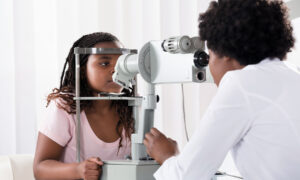December 1, 2022
By Dwight Akerman, OD, MBA, FAAO, FBCLA, FIACLE
 The World Health Organization (WHO) declared a global COVID-19 pandemic in March 2020. Many countries imposed social restrictions such as citywide lockdowns, extensive home confinements, or school closures. By April 2020, 151 countries worldwide had implemented countrywide or partial school closures, with most countries replacing in-person lessons with intensive home-based online learning. Given that these restrictions are unprecedented and may directly influence time outdoors or screen time, concerns regarding the potential effects of COVID-19 pandemic-related lifestyle on possible surges in “quarantine myopia” worldwide have been raised. Furthermore, with COVID-19 likely persisting as a public health threat in the medium to long term, and the increasing access to and reliance on digital devices, any potential impacts on myopia may extend beyond the pandemic.
The World Health Organization (WHO) declared a global COVID-19 pandemic in March 2020. Many countries imposed social restrictions such as citywide lockdowns, extensive home confinements, or school closures. By April 2020, 151 countries worldwide had implemented countrywide or partial school closures, with most countries replacing in-person lessons with intensive home-based online learning. Given that these restrictions are unprecedented and may directly influence time outdoors or screen time, concerns regarding the potential effects of COVID-19 pandemic-related lifestyle on possible surges in “quarantine myopia” worldwide have been raised. Furthermore, with COVID-19 likely persisting as a public health threat in the medium to long term, and the increasing access to and reliance on digital devices, any potential impacts on myopia may extend beyond the pandemic.
There is a shortage of evidence-based reviews summarizing the current literature on this relevant topic of public health concern. Hence, Li, et al. aimed to conduct: (1) a systematic review to assess the effects of COVID-19 pandemic-related lifestyle on myopia outcomes and (2) meta-analyses to quantify changes in cycloplegic spherical equivalent (SE) during COVID, compared with pre-COVID.
The researchers included seven articles (six prospective cohorts; one repeated cross-sectional study) comprising 6,327 participants aged 6 to 17. In all seven studies, SE moved toward a myopic direction during COVID (vs. pre-COVID), where five reported significantly faster myopic shifts [difference in means of changes: −1.20 to −0.35 diopters per year, [D/y]; pooled estimate: −0.73 D/y; 95% confidence interval (CI): −0.96, −0.50; P<0.001], and two reported significantly more myopic SE (difference in means: −0.72 to −0.44 D/y; pooled estimate: −0.54 D/y; 95% CI: −0.80, −0.28; P<0.001).
Three studies reported higher myopia (SE ≤−0.50D) incidence (2.0- to 2.6-fold increase) during COVID versus pre-COVID. Of studies assessing lifestyle changes, all four reported lower time outdoors (pre-COVID vs. during COVID: 1.1–1.8 vs. 0.4–1.0 hours per day, [h/d]), and three reported higher screen time (pre-COVID vs. during COVID: 0.7–2.8 vs. 2.4–6.9 h/d).
This review suggests significantly more myopic SE shifts during COVID vs. pre-COVID in participants aged 6 to 17. Overall, in all seven studies included in this review, there was evidence that the COVID-19 pandemic-related lifestyle had adversely impacted SE in a more myopic direction. The researchers concluded that potential negative consequences of the COVID-19 pandemic-related lifestyle on myopia need to be carefully considered in the design of future restriction measures, with minimal disruption to outdoor activities.
Abstract
Systematic Review and Meta-Analysis on the Impact of COVID-19 Pandemic-Related Lifestyle on Myopia
Mijie Li, Lingqian Xu, Chuen-Seng Tan, Carla Lanca, Li-Lian Foo, Charumathi Sabanayagam, Seang-Mei Saw
Purpose: To conduct a systematic review and meta-analysis to assess the effects of coronavirus disease 2019 (COVID-19) pandemic-related lifestyle on myopia outcomes in children to young adults.
Methods: A systematic search was conducted on PubMed, Embase, and the Cochrane Central Register of Controlled Trials databases (with manual searching of reference lists of reviews). Studies included assessed changes in myopia-related outcomes (cycloplegic refraction) during COVID and pre-COVID. Of 367 articles identified, 7 (6 prospective cohorts; 1 repeated cross-sectional study) comprising 6,327 participants aged 6 to 17 were included. Quality appraisals were performed with Joanna Briggs Institute Critical Appraisal Checklists. Pooled differences in annualized myopic shifts or mean spherical equivalent (SE) during COVID and pre-COVID were obtained from random-effects models.
Results: In all seven studies, SE moved toward a myopic direction during COVID (vs. pre-COVID), where five reported significantly faster myopic shifts [difference in means of changes: -1.20 to -0.35 diopters per year, [D/y]; pooled estimate: -0.73 D/y; 95% confidence interval (CI): -0.96, -0.50; P<0.001], and 2 reported significantly more myopic SE (difference in means: -0.72 to -0.44 D/y; pooled estimate: -0.54 D/y; 95% CI: -0.80, -0.28; P<0.001). Three studies reported higher myopia (SE ≤-0.50 D) incidence (2.0- to 2.6-fold increase) during COVID versus pre-COVID. Of studies assessing lifestyle changes, all four reported lower time outdoors (pre-COVID vs. during COVID: 1.1-1.8 vs. 0.4-1.0 hours per day, [h/d]), and three reported higher screen time (pre-COVID vs. during COVID: 0.7-2.8 vs. 2.4-6.9 h/d).
Conclusions: This review suggests more myopic SE shifts during COVID (vs. pre-COVID) in participants aged 6 to 17. COVID-19 restrictions may have worsened SE shifts, and lifting restrictions may lessen this effect. Evaluations of the long-term effects of the pandemic lifestyle on myopia onset and progression in large studies are warranted to confirm these findings.
Li, M., Xu, L., Tan, C. S., Lanca, C., Foo, L. L., Sabanayagam, C., & Saw, S. M. (2022). Systematic Review and Meta-Analysis on the Impact of COVID-19 Pandemic–Related Lifestyle on Myopia. The Asia-Pacific Journal of Ophthalmology, 11(5), 470-480.
DOI: 10.1097/APO.0000000000000559













